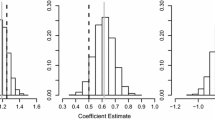Abstract
Habitat association models are commonly developed for individual animal species using generalized linear modeling methods such as logistic regression. We considered the issue of grouping species based on their habitat use so that management decisions can be based on sets of species rather than individual species. This research was motivated by a study of western landbirds in northern Idaho forests. The method we examined was to separately fit models to each species and to use a generalized Mahalanobis distance between coefficient vectors to create a distance matrix among species. Clustering methods were used to group species from the distance matrix, and multidimensional scaling methods were used to visualize the relations among species groups. Methods were also discussed for evaluating the sensitivity of the conclusions because of outliers or influential data points. We illustrate these methods with data from the landbird study conducted in northern Idaho. Simulation results are presented to compare the success of this method to alternative methods using Euclidean distance between coefficient vectors and to methods that do not use habitat association models. These simulations demonstrate that our Mahalanobis-distance-based method was nearly always better than Euclidean-distance-based methods or methods not based on habitat association models. The methods used to develop candidate species groups are easily explained to other scientists and resource managers since they mainly rely on classical multivariate statistical methods.
Similar content being viewed by others
References
Alldredge JR, Thomas DL and McDonald LL (1998). Survey and comparison of methods for study of resource selection. J Agri Biol Envir Stat 3: 237–253
Atkinson AC (1994). Fast very robust methods for the detection of multiple outliers. J Am Stat Assoc 89: 1329–1339
Atkinson AC and Riani M (2001). Regression diagnostics for binomial data from the forward search. J Roy Stat Soc Ser D 50: 63–78
Banfield JD and Raftery AE (1993). Model-based Gaussian and non-Gaussian clustering. Biometrics 49: 803–821
Bate LJ (1999). Draft literature review for Upper Columbia River Basin ecosystem management project. Draft Report. Kalispell, MT
Collett D (1991). Modelling binary data. Chapman and Hall, London
Fahrmeir L and Kaufmann H (1985). Consistency and asymptotic normality of the maximum likelihood estimator in generalized linear models. Ann Stat 13: 342–368
Hejl SJ, Hutto RL, Preston CR, Finch DM (1995) Effects of silvicultural treatments in the Rocky Mountains. In: Martin T, Finch DM (eds) Ecology and management of neotropical migratory birds. Oxford University Press, New York, pp 220–244
Hutto RL (1995). The composition of bird communities following stand-replacement fires in northern Rocky Mountain (USA) conifer forests. Conserv Biol 9: 1041–1058
Hutto RL, Young JS (1999) Habitat relationships of landbirds in the northern Region. General Technical Report RMRS-GTR-32, USDA Forest Service, Ogden, Utah
Johnson RA and Wichern DW (1982). Applied multivariate statistical analysis. Prentice-Hall, New Jersey
Lambeck RJ (1997). Focal species: a multi-species umbrella for nature conservation. Conserv Biol 11: 849–856
Lundquist RW, Mariani JM (1991) Wildlife and vegetation of unmanaged Douglas-fir forests. In: Ruggiero LF, Aubry KB, Carey AB, Huff MH (eds) General Technical Report PNW-GTR-285, USDA Forest Service, Pacific Northwest Research Station, Portland, Oregon
Mardia KV, Kent JT and Bibby JM (1979). Multivariate analysis. Academic Press, New York
McCullagh P and Nelder J (1989). Generalized linear models. Chapman and Hall, New York
Milligan GW (1980). An examination of the effect of six types of error perturbation on fifteen clustering algorithms. Psychometrika 45: 325–342
Milligan GW, Soon SC and Sokol LM (1983). The effect of cluster size, dimensionality, and the number of clusters on recovery of true cluster structure. IEEE T Pattern Anal PAMI-5 1: 40–47
Mussehl T, Schladweiler P, Weckwerth R (1971) Forest grouse. In: Mussehl TW, Howell FW (eds) Game management in Montana, Montana Fish and Game Dept., Game Management Division, Helena, MT, pp 143-151
Neimi GJ, Hanowski JM, Lima AR, Nichols T and Weiland N (1997). A critical analysis on the use of indicator species in management. J Wildlife Manage 61: 1240–1252
Park PS and Kshirsagar AM (1994). Distances between normal populations when covariance matrices are unequal. Commun Stat 23: 3549–3556
Ralph CJ, Geupel GR, Pyle P, Martin TE, Desanke DF (1993) Handbook of field methods for monitoring landbirds. General Technical Report. PSW-GTR-144. USDA, Pacific Southwest Research Station, Forest Service, Albany, California
Ramsey FL, McCracken M, Crawford JA, Drut MS, Ripple WJ (1994) Habitat association studies of the Northern Spotted Owl, Sage Grouse, and Flammulated Owl. In: Lange N, Ryan L, Billard L, Brillinger D, Conquest L, Greenhouse J (eds) Case studies in Biometry. John Wiley and Sons, New York
Root RB (1967). The niche exploitation pattern of the Blue-gray Gnatcatcher. Ecol Monogr 37: 317–350
Rousseeuw PJ (1984). Least median of squares regression. J Am Stat Assoc 79: 871–880
SAS Institute Inc (1985) SAS user’s guide: statistics. Version 5. SAS Institute, Inc., Cary, North Carolina
SAS Institute Inc (1989) SAS/IML software: Usage and reference. Version 6. First edition, SAS Institute, Inc., Cary, North Carolina
SPLUS (1997) S-PLUS 4 guide to statistics. MathSoft, Inc., Seattle, Washington
Thomas WA 1972. Indicators of environmental quality: an overview. In: Thomas WA (ed) Indicators of environmental quality. Plenum Press, New York
Van Horne B, Wiens JA (1991) Forest bird habitat suitability models and the development of general habitat models. Fish and Wildlife Research Report No. 8, U.S. Fish and Wildlife Service
Verner J (1984). The guild concept applied to management of bird populations. Environ Manage 8: 1–14
Williams CJ, Heglund PJ (2000) Assignment of species into groups based on habitat usage. In: Proceedings of the Biometrics Section of the American Statistical Association pp 173–178
Wu TJ, Hsieh YC and Li LA (2001). Statistical measures of DNA sequence dissimilarity under Markov chain models of base composition. Biometrics 57: 441–448
Zoneveld IS (1983). Principles of bio-indicators. Environ Monit Assess 3: 207–217
Author information
Authors and Affiliations
Corresponding author
Rights and permissions
About this article
Cite this article
Williams, C.J., Heglund, P.J. A method for assigning species into groups based on generalized Mahalanobis distance between habitat model coefficients. Environ Ecol Stat 16, 495–513 (2009). https://doi.org/10.1007/s10651-008-0093-9
Received:
Revised:
Published:
Issue Date:
DOI: https://doi.org/10.1007/s10651-008-0093-9




